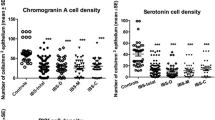Abstract
Background and aims
Recent studies have demonstrated decreased numbers of interstitial cells of Cajal in patients suffering from severe chronic constipation as measured by c-Kit (CD117) and CD34 immunohistology. In this study, we wished to determine whether there were abnormalities in the number of neurons of the Auerbach's plexus, their CD117 and CD34 immunoreactivity, or the thickness of colon wall sections in patients with refractory slow transit colonic constipation as compared with control subjects.
Patients and methods
Specimens from 13 patients who had undergone subtotal colectomy for severe chronic constipation refractory to medical treatment were compared with normal controls. Enteric neurons of Auerbach's plexus were counted, and thickness of the circular and longitudinal layer of the muscularis externa as well as total muscularis externa was measured. Quantitative assessment of anti-CD117 and anti-CD34 immunoreactivity was performed using an Automated Cellular Imaging System and expressed as fractional scores.
Results
Except for a decreased circular muscle layer thickness in the constipated patients, no statistically significant differences were observed between the two groups. In particular, there was no relationship between CD117/CD34 fractional staining score and the duration or severity of disease, despite the selection of highly symptomatic individuals requiring colonic resection.
Conclusion
Using quantitative immunohistochemistry for CD117/CD34, we could not detect a relationship between fractional CD117/CD34 staining score and chronic constipation as compared to controls.


Similar content being viewed by others
References
Jain D, Moussa K, Tandon M et al (2003) Role of interstitial cells of Cajal in motility disorders of the bowel. Am J Gastroenterol 98:618–624
Daniel EE (2001) Physiology and pathophysiology of the interstitial cell of Cajal: from bench to bedside. III. Interaction of interstitial cells of Cajal with neuromediators: an interim assessment. Am J Physiol Gastrointest Liver Physiol 281:G1329–G1332
Lyford GL, He CL, Soffer E et al (2002) Pan-colonic decrease in interstitial cells of Cajal in patients with slow transit constipation. Gut 51:496–501
Sabri M, Barksdale E, Di Lorenzo C (2003) Constipation and lack of colonic interstitial cells of Cajal. Dig Dis Sci 48:849–853
Streutker CJ, Huizinga JD, Campbell F et al (2003) Loss of CD117 (c-kit)- and CD34-positive ICC and associated CD34-positive fibroblasts defines a subpopulation of chronic intestinal pseudo-obstruction. Am J Surg Pathol 27:228–235
Tong WD, Liu BH, Zhang LY et al (2004) Decreased interstitial cells of Cajal in the sigmoid colon of patients with slow transit constipation. Int J Colorectal Dis 19:467–473
Wedel T, Spiegler J, Soellner S et al (2002) Enteric nerves and interstitial cells of Cajal are altered in patients with slow-transit constipation and megacolon. Gastroenterology 123:1459–1467
Vanderwinden JM, Rumessen JJ, De Laet MH et al (1999) CD34+ cells in human intestine are fibroblasts adjacent to, but distinct from, interstitial cells of Cajal. Lab Invest 79:59–65
Wang S, Saboorian MH, Frenkel EP et al (2001) Assessment of HER-2/neu status in breast cancer: Automated Cellular Imaging System (ACIS)-assisted quantitation of immunohistochemical assay achieves high accuracy in comparison with fluorescence in situ hybridization assay as the standard. Am J Clin Pathol 116:495–503
Vanderwinden JM, Rumessen JJ, De Laet MH et al (2000) CD34 immunoreactivity and interstitial cells of Cajal in the human and mouse gastrointestinal tract. Cell Tissue Res 302:145–153
Kindblom LG, Remotti HE, Aldenborg F et al (1998) Gastrointestinal pacemaker cell tumor (GIPACT): gastrointestinal stromal tumors show phenotypic characteristics of the interstitial cells of Cajal. Am J Pathol 152:1259–1269
Hirota S, Isozaki K, Moriyama Y et al (1998) Gain-of-function mutations of c-kit in human gastrointestinal stromal tumors. Science 279:577–580
Sircar K, Hewlett BR, Huizinga JD et al (1999) Interstitial cells of Cajal as precursors of gastrointestinal stromal tumors. Am J Surg Pathol 23:377–389
Song G, David G, Hirst S et al (2005) Regional variation in ICC distribution, pacemaking activity and neural responses in the longitudinal muscle of the murine stomach. J Physiol 564:523–540
Hirst S, Dickens EJ, Edwards FR (2002) Pacemaker shift in the gastric antrum of guinea-pigs produced by excitatory vagal stimulation involves intramuscular interstitial cells. J Physiol 541:917–928
Author information
Authors and Affiliations
Corresponding author
Rights and permissions
About this article
Cite this article
Toman, J., Turina, M., Ray, M. et al. Slow transit colon constipation is not related to the number of interstitial cells of Cajal. Int J Colorectal Dis 21, 527–532 (2006). https://doi.org/10.1007/s00384-005-0041-1
Accepted:
Published:
Issue Date:
DOI: https://doi.org/10.1007/s00384-005-0041-1




